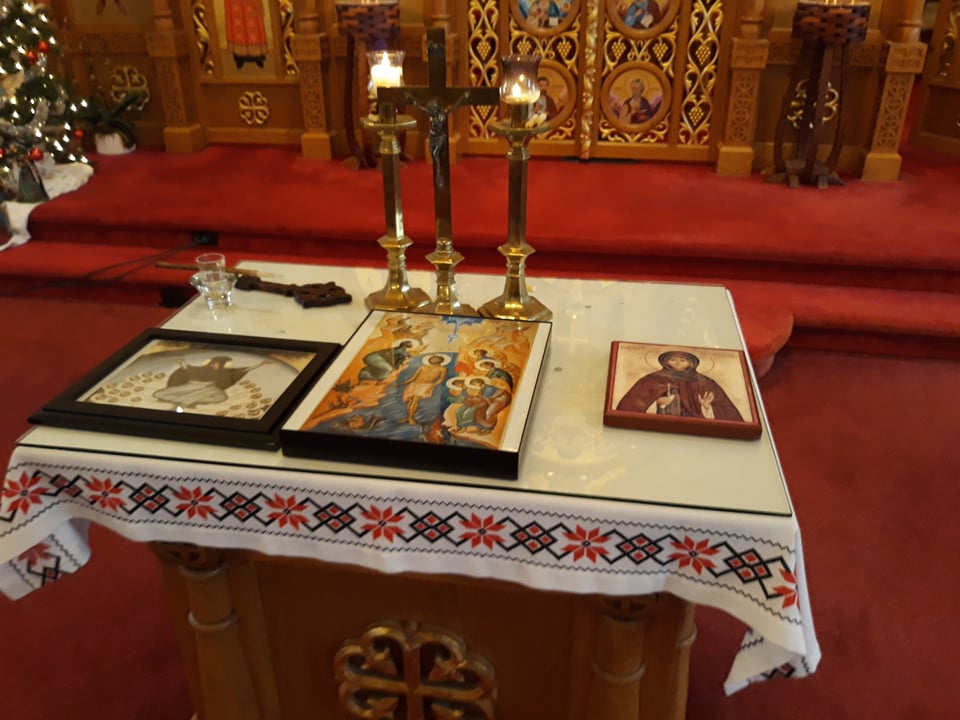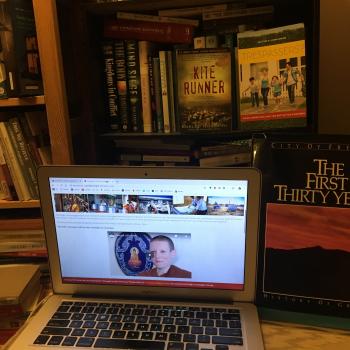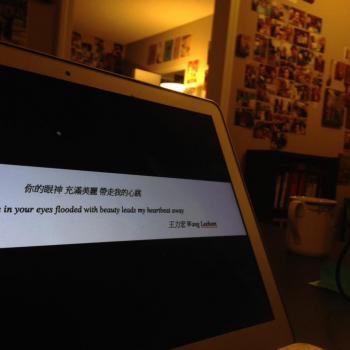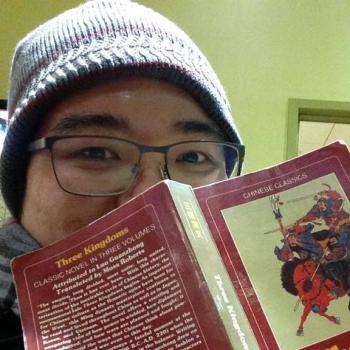
Eugenia Geisel is one of my former students at the University of Washington and is now a new colleague on the Catholic blogosphere. When I first told her about Orthodox icons having lipstick stains on them, she remarked that she’d be one to leave them. Given the Latin Church’s emphasis on the three-dimensional body as iconic, she imagined that she might leave them on her relics too. Thus was her new blog born. Lipstick on My Relics, she calls it.
I suppose I have something to do with the launching of this blog. Over the last year, Eugenia has been dropping guest posts on my blog reflecting on her time in Kraków for World Youth Day. She has posts on her encounters with the Theotokos of Częstochowa, Bl Jerzy Popieluszko, St Faustina Kowalska, St Albert Chmielowski, and St Maximilian Kolbe. In her two final posts, she performs a reading of the Coen Brothers’ Hail Caesar! en route to a meditation on Pope St John Paul II.
Yesterday, I was reminded by Sam Rocha about why I tolerated all of this on a blog where I claim to be ‘Orthodox in communion with Rome.’ Eugenia came up from Seattle to Richmond for our Theophany celebrations. ‘She’s here?!’ my wife asked incredulously when she spotted her. ‘Did you know?!’ I had forgotten. But it seemed so natural too. Our joke is that someday she will be our temple’s ‘khouria,’ our priest’s wife. There’s no indication that this will ever become a reality. But then again, we are a people of kairos.
My spiritual father certainly has her on his mind. He had gone on a retreat a few months before and come back with an icon of her patron saint, St Eugenia. It has sat in my icon corner in Richmond for months. It was time for Eugenia to finally pick up her icon, so it was good for her to come up to get it. After liturgy the other day, they blessed the icon, after which it sat on the tetrapod for our whole temple’s veneration. Hearing about the blessing prompted me to remember the origins of Lipstick on My Relics. Self-interestedly mindful that she’d be an incredible khouria, I joked on Facebook that we are praying for Eugenia’s blog to become Lipstick on My Icons.
Sam immediately countered. Relics are iconic, he said, and when I replied that we have relics too, he replied that there is no we. I have so fully internalized the Kyivan Church’s inferiority complex that I thought he was undermining our sui juris status, not to mention the radical conspiracy among some of us to enact a project of double communion between Rome and Constantinople (or triple, if Moscow behaves). I took a breath and asked him what exactly he meant. He replied that there is no we when it comes to iconic relics. The supernatural is a constitutive part of material reality. It is objectively just there. I know better than this. As John Panteleimon Manoussakis shows, Sam’s reasoning is the conciliar rationale in the Second Council of Nicaea about icons: Christ enters the economy, the inhabitation of the earth that he manages, in material flesh, transforming it through his imaging of God into an iconomy.
I really should have known better. In fact, Eugenia has told the world on her new blog that it is I who taught her these concepts at the University of Washington. Citing one of my posts from the summer, she writes in her ‘About’ page:
Join me as I try to find it in the everyday, encountering what I call the everyday supernatural.This term that I coined is defined quite well by my mentor and former professor Justin Tse who says: “the unexpected encounters with grace that are rightfully ordinary because it is simply true that the world is infused with a spiritual order that comes from above… The everyday supernatural is about what happens when persons face each other, when the world is truly encountered, when the mess of the quotidian is the source of grace”.
My Catholic students at the University of Washington, Eugenia included, tell me that my teaching on the supernatural tended to be their takeaway from my classes; students in Asian American religions at Northwestern are beginning to say the same. For me, there is some irony to this compliment, as I approached the supernatural as an academic topic through Radical Orthodoxy, a framework that has since fallen apart for me.
Fortunately, my source when I taught was not John Milbank. It was Henri de Lubac’s Corpus Mysticum and Surnaturel.
In Corpus Mysticum, de Lubac discusses how the Eucharist is not just a transubstantiation of bread and wine into the Body and Blood of Christ. Exegeting St Augustine, de Lubac finds that we become the Body and Blood when we ingest the Eucharist. We become linked through the material, because matter itself is supernaturally constituted. As de Lubac demonstrates from Christian tradition in Surnaturel, God does not impose his grace onto the natural world, as if there could possibly be a ‘pure nature’ that is not always already infused with his energies. Before the modern sundering of nature and the spiritual dimension, the supernatural was just there. Of course it is experienced in the everyday. In fact, the larger context of the work of de Lubac’s student Michel de Certeau is that this sensibility has never really gone away, not even modernity. From The Possession at Loudun to The Mystic Fable, de Certeau argues that the suppression of the supernatural simply leads to people acting out, fragmenting their spiritual sensibilities as they try to describe what they know to be there. The Practice of Everyday Life is the methodological reduction of de Certeau’s findings in early modern Europe; from there, he suggests that we can investigate the everyday worlds that we inhabit too.
In her guest posts on my blog, Eugenia retraces her walking through the city of Kraków. Appropriating the term ‘city of saints’ from the neoconservative ideologue George Weigel, she tries in each post to become more and more comfortable with what de Certeau is talking about. She is relaying her unexpected glimpses of the supernatural constitution of reality in her pied-à-terre, boots-on-the-ground exploration of the city. De Certeau has a chapter in The Practice of Everyday Life titled ‘Walking in the City’ where he describes what Eugenia is doing. There are these big, bureaucratic edifices, the Church included – and for Eugenia, they might even be World Youth Day. However, what is always interesting about cities is how persons themselves make use of these large apparatuses.
Eugenia becomes more and more comfortable with this dynamic as she writes. In the first few posts, she is trying to tell you how things are. This is how the Black Madonna works: ‘And I am reminded of what I learned at the airport: Run to her. Always.’ This is why you should join Blessed Jerzy in his quest for solidarity: ‘At the same time, now more than ever it is imperative that we carry each other’s’ burdens and position ourselves in solidarity with the poor and the marginalized. It is the only proven way to authentically and effectively confront hatred, corruption, and violence – in short, systematic sin.’ This is what Divine Mercy is about: ‘For me, the message of Divine Mercy that St. Faustina helped to bring into a hurting world is threefold’ – and then she spells out her three points like a homily. But by the time she gets to St Albert, there is a subtle shift in tone. She and her friends encounter a hungry person named Klaudia and her family. They fed them, prayed with them, and were bewildered by the experience: ‘After that we had to say our goodbyes and rush off to the train station. I don’t know Klaudia’s story, I don’t know what her situation is, all I know is that she and her family needed something to eat, and even more than that they needed what we all need: someone to care.’ From telling you what the supernatural should be, Eugenia becomes increasingly relaxed as she relates how she has glimpsed the divine and the hagiographic in a city she is exploring in all of its glorious weirdness. She moves from evangelist to artist, from telling you the Gospel to showing its power in deed. By the time she sees herself and Wojtyła in the character of Eddie Mannix in Hail Caesar!, she seems to be getting the hang of writing about the everyday supernatural. The imperatives become fewer. The exploratory hesitation becomes more pronounced. Eugenia is walking through the city of saints.
A commitment to the everyday supernatural requires this change of disposition. Eugenia knows it well enough: she saw it in my personal transformation during my time teaching at the University of Washington. I had an intellectual crisis while teaching, and I related much of it in my series on liberation theology. But Eugenia saw it in the classroom. I started out very confidently, declaring what trans-Pacific Christianities were and were not, to the point of bombastically proclaiming that Eastern Christianities are not Asian Christianities as the latter descends from Western missionary work. But as what I said made increasingly less sense, I began to relate to my students my journey. It wasn’t until the end of the class that I began teaching them about the everyday supernatural as what I had begun to experience myself and how I began to see my scholarly journey. As one of the Polish Dominicans said to me during that time, the fact that truth is objective should make us less able to grasp it, for to seize it is to have already subjectivized it. I suspect it’s because of the everyday supernatural that the students who suffered through that class came to love it. Without grace, the course would have been a failure.
But then, there is nothing that is not already supernatural.
I suppose here is where relics come in. Bill Cavanaugh reminds us in Torture and Eucharist that the veneration of relics took on a pronounced form in the Latin Church because of the severe persecution and martyrdom that took place in the Roman Empire before Constantine. Though some of the sisters and brothers in Christ had died, they were still present, not least through the remnants of their physical bodies. There is some precedent for this phenomenon in Scripture. A man is raised to life in the Book of Kings by rolling against the Prophet Elisha’s reposed body. Some are healed through handkerchiefs and aprons touched by the Holy Apostle Paul. When the Holy Apostle Peter’s shadow passed by sick persons, they were cured. Relics are the remnants of holiness, and the holy makes material whole.
To reflect on the everyday supernatural is to be fully conscious of the relics that continue to inhabit a world that most people take by common sense to be ‘secular.’ Eugenia is demonstrating that ignoring the presence of the holy while walking through the city is to be caught in ideology. Instead of describing what is there, there is an imposition. Imposing, however, is how we are educated. There is a journey toward writing about the everyday supernatural because we need to let go of our secular certainty and move toward the ambivalence and ambiguity of describing the grace that is palpable but slips through our words.
There is some humor to this task. When Eugenia came up this Theophany, we had fun. First, she was thrown into the liturgical deep end with a friend of hers who served as an impromptu ‘kliros’ to augment the singing. The next day, we went for coffee with a friend from the temple. Coffee turned into lunch, and lunch turned into a second meal with my spiritual father, who wanted to eat the fatty pork belly that Mao Zedong loved to eat and by which he got really fat later in life. It’s called dong po rou. Every Theophany, my spiritual father likes to eat things he doesn’t get to eat while on his strict monastic fasting regimen. One year, it was scorpion. Last year, it was frog fallopian tubes – or as he tried to soften the blow, the fat around the frog fallopian tubes. This year, it was dong po rou. And because Eugenia just happened to be in town, she came along for the ride.
Again, Eugenia is moving through the city, but here, the everyday supernatural might even be said to be the church moving through the city as a supernatural presence. It’s not Theophany in Richmond, per se, but it was Theophany for us. Because of this, our movements change: my spiritual father can eat meat, the most exotic kind. Like the waters blessed at Theophany, we move through the city of Richmond refreshed, hungry, consuming foods we don’t normally eat, feasting. The waitress at the restaurant was very puzzled by our presence. She kept raising eyebrows as we ordered these unusual foods. She kept looking at our table as we laughed and laughed and laughed. The everyday supernatural can be hilarious.
It seems to me that Eugenia’s writing is increasingly about chronicling these adventures in a world that is always already infused by the holy. She tells me that she is going to keep writing about herself making her way through this supernatural order, and there is no reason to doubt that: in addition to her record on my blog, she is already the Queen of this sensibility on Twitter. But she also informs me that she plans to write about other people who have tapped into the relics of spiritual constitution in the contemporary world. I won’t give those away, but I am very much looking forward to reading her stuff. It’s not because it will be Latin, or Byzantine, or Kyivan – though she really could do the latter, as she was a Slavic literature minor. It’s because she’s writing of her experience of the supernatural as it is just there in everyday life. I won’t be reading that to reinforce my identity. If anything, it’s going to help me refine my thinking about the concept that I taught her so imperfectly.















